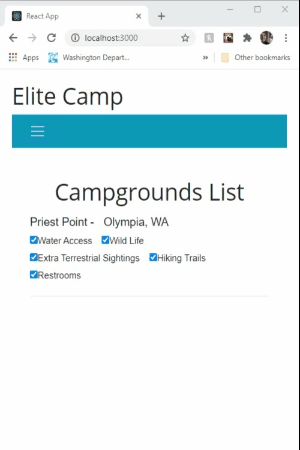MERN Stack CRUD Operations Application
M.E.R.N.
MySQL - Express.js - React.js - Node.js
Express.js
Express stands as an extremely flexible backend framework. Communicating with the front end client doesnt take much minipulation from the developer. While laying a web-framework for Node.js, helping with HTTP requests, and allowing the developer to create the necessary middleware, it maintains being fast, minimalist, and, un-opinionated.
var express = require("express");
var router = express.Router();
var models = require("../models");
router.get("/", function(req, res, next) {
models.User.findAll().then(users => res.json(users));
});
router.post("/", function(req, res, next) {
let newUser = new models.User();
newUser.FirstName = req.body.FirstName;
newUser.LastName = req.body.LastName;
newUser.Username = req.body.Username;
newUser.Password = req.body.Password;
newUser.save().then(user => res.json(user));
});
"development": {
"username": "root",
"password": "Password1!",
"database": "elitecamp",
"host": "localhost",
"dialect": "mysql",
"define": { "timestamps" : false }
},
module.exports = (sequelize, DataTypes) => {
const User = sequelize.define(
"User",
{
user_id: {
type: DataTypes.INTEGER(5).UNSIGNED,
allowNull: false,
primaryKey: true,
autoIncrement: true
},
FirstName: {
type: DataTypes.STRING(45),
allowNull: false
},
MySQL
Setting up your application using MySQL as your database management tool. Combining with the Sequelize CLI creates a seemless way to integrate data to and from your application
sequelize init
Generates Three Folders:
- models - contains an index.js file
- migrations - contains no files
- seeders - contains no files
In the case your database is already populated by utilizing the CLI you can generate a model file that is prepopulated with all of the table data that is requested.
sequelize-auto -h "IP/Hostname for the database (required)" -d "Database name (required)" -u "Username for database" -x "Password for database" -o "What directory to place the models" -t "Comma-separated names of tables to import"
While utilizing the previously installed Sequelize running your server
npm start
(or using nodemon), will populate tables with any data defined in the models folder into the database your project is sync’d up to.
In the case you dont want to write your models by hand check out -
npx sequelize-cli model:generate --name "Table Name" --attributes "Defined objects, i.e."row name":integer or "row name":string
Node.js
A JavaScript runtime environment for servers and applications, Node.js the cross-platform proved itself to be extremely valuable in this stack application. Built on Google’s V8 JavaScript engine, Node.js is efficient and light weight making a perfect environment for Express.js, which helps handle routing the HTTP request coming from the clients.
var express = require("express");
var router = express.Router();
var models = require("../models");
router.get("/", function(req, res, next) {
models.User.findAll().then(users => res.json(users));
});
React
Chosing React for the front end framework set out to be a challenging pursuit. Although this project only breaks the surface of its potential, it shows how well it works within this MERN stack application that employs the four CRUD operations. A significant feature that is important to point out is the ability to create a component, and how these components have endless possibilities. While most components were used in this project to display pages in the user interface, another component was created with a sole purpose of being a navigation bar. The components built in the client side will eventually be imported into one file and pushed into the single html file (single page application) which in turn displays the user interface. There is many similarities to javascript, but the composed rendered language used in react is JSX, it is slightly altered, so it is a good idea to study up on those differences. With that being said, it is important to focus on the request function going to the controller but learning how to write the necessary JSX to push and pull to the database can sometimes be the real obstacle.
<div className="form-group">
<label htmlFor="address" className="h5 mr-3 font-weight-normal">
Address:
</label>
<input type="text"
className="form-control"
name="address"
placeholder="Address"
ref={this.campAddress}/>
</div>
<div className="form-group">
<label htmlFor="waterAccess" className="h5 mr-3 font-weight-normal">
Water Access
</label>
<input type="checkbox"
className="checkbox"
name="waterAccess"
checked={this.state.campWater}
onChange={this.campWaterToggle}/>
</div>
CheckBoxes
Inputs can be challenging to work with, and when they dictate a true or false entry into a database the science becomes finicky to say the least. Though it is tough to explain, setting up the request function to obtain the state of the check box is the first hurdle.
addCampground = () => {
let url = "http://localhost:3001/campgrounds";
axios.post(url, {
campgroundName: this.campName.current.value,
address: this.campAddress.current.value,
waterAccess: this.state.campWater,
wildLife: this.state.campWild,
ET: this.state.campET,
trails: this.state.campTrails,
restrooms: this.state.campRestrooms
}).then(response => {
I mentioned earlier that the request function is important but the conclusion I came to was understanding the JSX involved proved to be the more important lesson to study. First wiring up the inputs to report their current state is careful work, but once you get one working the rest pile up quickly with simple copy, paste and changes to the names they correspond with.
<label
htmlFor="address"
className="h5 mr-3 font-weight-normal">
{p.address}
</label>
<br />
<label className="h6 mr-3">
<input type="checkbox"
name="waterAccess"
checked={p.waterAccess}
readOnly/>
Water Access
</label>
Above is a readOnly input, it is not available for selection. However for manipulable inputs you will see a
<label>
<input type="checkbox"
className="checkbox"
name="waterAccess"
checked={this.state.campWater}
onChange={this.campWaterToggle}/>
</div>
in addition to…
campWaterToggle = (evt) => {
this.setState({
campWater: !this.state.campWater
});
console.log(!this.state.campWater)
}
Presentation


